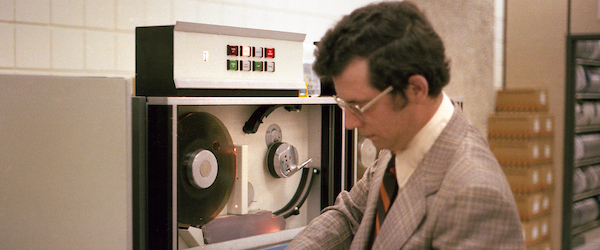In the above video Admiral Grace Hopper – the Mother of Computing – explains the significance of a nanosecond to David Letterman. Hopper visited the University of Regina in 1974.
Submitted by:
Larry Symes
Professor Emeritus
Department of Computer Science
(Originally published on 9 December 2010 in Your Official U of R blog)
The phrase “If it is not tied down, move it”, the significance of 11.8 inches, the term ‘computer bug’, and a glimpse at the beginning of the computer revolution through the eyes of a woman who experienced it from the front row were some of the pearls that Captain Grace Hopper left the students, faculty and members of the Regina community to reflect upon after her visit to Regina in November of 1974 to deliver the Basterfield Lecture.
The visit of Captain Hopper was a “coming out” celebration for the Computer Science Department. The Computer Science Department was created in 1968 as a campus department, but its first faculty member was not appointed until July 1, 1970. Until the Fall of 1971, Computer Science classes were offered by the Faculty of Administration and the Department of Mathematics.
By 1974 the Department had designed and received approval for its undergraduate programs, produced its first graduates, grown to four faculty members and become a member of the Faculty of Arts and Science’s then Division of Natural Sciences and Mathematics. Hosting the Basterfield Lecture was indeed a significant milestone.
Computer bug
Rear Admiral Grace Murray Hopper (December 9, 2006 – January 1, 1992) truly deserves the title of the Mother of Computing. She was one of the initial members of the team that programmed Howard Aiken’s MARK I at Harvard University during the 1940’s. During that time she was credited with popularizing the phrase “computer bug” —a term that we are all too familiar with, after a moth having found its way into one of the MARK I’s electro magnetic relays caused it to fail.
She noted that the programming team for the MARK I was mainly made up of women. While the war may have altered employment demographics in the early 1940’s, it did not affect student demographics when I started teaching computing the later half of the 1960’s. Then the proportion of women studying the discipline approximated that in the normal population—50%. I leave you to answer the question as to why the change in numbers?
In 1949 Dr. Hopper left Harvard Computational Laboratory to join the Eckert-Mauchly Computer Corporation that was developing the UNIVAC I, a machine so powerful that it was predicted only four would be needed to supply the computational needs of the world. Here she worked in the new field of programming languages and compilers to translate these new languages into machine code. Her work in this area led to her participation in a standards group in the 1950’s, which led to the development of the language COBOL. COBOL permitted the programmer to write instructions in an English-like language which then could be translated (compiled) into machine language for a machine to execute. Furthermore, programs written in COBOL that followed the prescribed standards were transferable between machines of various vendors.

The operators of the Mark II Aiken Relay Calculator found this moth trapped in the system and added it to their log in September 1947 with the entry: “First actual case of bug being found”. Photo via the U.S. Naval Historical Center Online Library, Naval Surface Warfare Center, Dahlgren, VA.
If it is not tied down, move it.
The advice “if it is not tied down, move it” was given at a session with students and faculty in response to a comment about the need for a piece of furniture for the talk. For a department needing additional resources to grow, it was indeed timely.
11.8 inches
The significance of 11.8 inches is that this is the distance that electricity can travel in 1 nanosecond (1 billionth of a second—10-9 seconds). Captain Hopper arrived at the lecture theatre in the classroom building armed with a huge roll of wire and a small bundle of wires with each piece cut to a length of 11.8”. She used the two lengths of wire to emphasize how computer speed was increasing. During the lecture she lifted the huge role of yellow wire (984 feet in length) explaining that it represented the distance that electricity would travel in one microsecond which was about the 1/1,000 of the speed of an electro mechanical relay used to build the MARK I. She then held up the bundle of wires cut to 11.8”, and while having one distributed to each member of the audience, explained the 11.8” was the distance that electricity could travel in one nanosecond—a speed that super computers of the 1970’s were approaching, and a speed now being approached by the processor in your cell phone and exceeded by your average portable computer.
